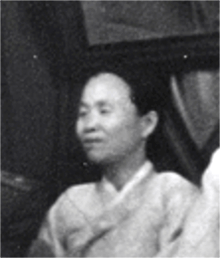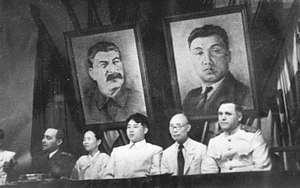Pak Chong-ae
| Pak Chong-ae | |
|---|---|
 | |
| Minister of Agriculture | |
|
In office 1961–1963 | |
| Personal details | |
| Born |
1907 North Hamgyong Province, Korea |
| Died | Sometime in or after 1986 |
| Nationality | North Korean |
| Political party | Workers' Party of Korea |
| Other political affiliations | Workers' Party of North Korea |
| Spouse(s) | Kim Yong-bom |
| Children | Pak Sun-hui |
| Alma mater | Moscow State University |
| Awards | International Stalin Prize (1950), Order of the National Flag (1st and 2nd class) |
| Korean name | |
| Chosŏn'gŭl | 박정애 |
| Hancha | 朴正愛[1] |
| Revised Romanization | Bak Jongae[2] |
| McCune–Reischauer | Pak Chŏng'ae[3] |
Pak Chong-ae (Korean: 박정애;[1] born Ch'oe Vera[4] 1907 – ?[lower-alpha 1]), also known as Pak Den-ai,[5] was a North Korean politician.
Pak represented the Workers' Party of North Korea (WPNK) and after 1949 the unified Workers' Party of Korea (WPK).[6] She was already an experienced communist at the time of the liberation of Korea, and she had also studied in the Soviet Union and worked for its intelligence service. She is grouped variously among either the Soviet or the Domestic faction of the party.[7][8]
Pak was the first chairperson of the North Korean Central Committee of the Korean Democratic Women's League, the country's mass organization for women. During her chairwomanship the League had not yet developed into an organization through which the government tightly controls its citizens.
Pak is the only woman to have served in the Politburo of the Workers' Party of Korea. She has been characterized as being the only woman ever to have been truly important in the WPK. Her career in North Korean politics stretched from the 1940s until her purge in 1966 which resulted in her expulsion to countryside. From there on she was allowed to hold minor positions only.
Pak was awarded with the International Stalin Prize in 1950.
Early life and career
Pak was born in 1907 in North Hamgyong Province in the north of the Korean Peninsula. She went to the Soviet Union to study in the Moscow State University.[1] She then worked for the Soviet Union as an intelligence agent before entering politics.[4][7] In the early 1930s, she was dispatched to Korea for duty,[7] where the Japanese authorities imprisoned her.[8]

During the 1940s, Pak was married to Kim Yong-bom, chairman of the North Korean Branch Bureau of the Korean Communist Party.[9] At the time of the liberation of Korea, Pak was already considered an experienced domestic communist.[10] She supported Kim Il-sung in the early days of North Korean political life and became one of his strongest supporters.[4] In August 1946, she became a full member of the 1st Central Committee of the Workers' Party of North Korea (WPNK).[11] When the Workers' Parties of North and South Korea merged to form the Workers' Party of Korea (WPK) in 1949, Pak was chosen as one of its three secretaries.[6] She served in its 2nd, 3rd, and 4th Central Committees.[11] She was also a deputy to the Supreme People's Assembly.[12]
It is possible that Pak informed the Chinese about North Korea's plans to attack South Korea just prior to the outbreak of the Korean War.[13]
In 1953, she participated in a purge against the former South Korean Workers' Party members who had fallen out of Kim Il-sung's favor. Pak became one of five members,[14] and the only woman,[8] in a Political Committee that solidified Kim's rule.[14] Pak was highly influential within the Committee and was one of Kim's closest confidantes.[15][16] She even accompanied him on trips abroad.[17] As one of the most important members of the Committee she was uniquely "able to advise Kim Il-sŏng on his personal life, and to speak for women as well as on matters of general concern".[15]
She was the first chairperson of the North Korean Central Committee of the Korean Democratic Women's League.[3] During her tenure, lasting from the 1940s to 1965,[9] the league was a typical women's mass organization not unlike those in other countries. It was only under subsequent chairpersons that it acquired more totalitarian features.[4] Pak also played a leading role in the Women's International Democratic Federation (WIDF).[18] She was a member of its Executive Committee in 1948. In 1951, a WIDF International Commission of Women visited North Korea on her initiative to mobilize the world public opinion.[19] She received the International Stalin Prize in 1950 and also starred in Joris Ivens and Jerzy Bossak's anti-war documentary film Peace Will Win.[20][21] She has also revived the North Korean Order of the National Flag, both first and second class.[1]
Robert A. Scalapino and Lee Chong-Sik call her "the only woman ever to have been truly important in the [WPK]".[22] She lasted in the mid-century North Korean political life ridden with purges for longer than most politicians.[23] Andrei Lankov describes her as "one of the most remarkable personalities of that remarkable era".[4] From 1961 to 1963 she was North Korea's Minister of Agriculture.[24] Pak is the only woman to have served in the Politburo of the Workers' Party of Korea, the highest decision-making body of the party.[25]
Pak herself was purged by Kim at the 2nd Conference of the WPK in October 1966. The conference saw purges of mostly officials in charge of economic affairs, but Pak was not one of them, implying that she was purged because of Kim's desire to concentrate power.[26] Pak was expelled to the countryside after the purge.[23] She resurfaced in public life in 1986.[23][7] Her influence had been greatly weakened by then and she was allowed to hold minor positions only.[23][4] Her daughter, Pak Sun-hui, is the current chairperson of the central committee of the Korean Democratic Women's League.[9]
See also
Notes
- ↑ Sometime in or after 1986
References
- 1 2 3 4 박정애(朴正愛) [Pak Chong-ae]. North Korean Human Geography (in Korean). Seoul: Institute for Peace Affairs. Retrieved 17 December 2016.
- ↑ Person, James F. (2007–2008). "New Evidence on North Korea in 1956". In Ostermann, Christian F. Cold War International History Project Bulletin: Inside China's Cold War. Woordrow Wilson International Center for Scholars. p. 448. GGKEY:18LFSRTZZ8J.
- 1 2 Armstrong, Charles K. (2013). The North Korean Revolution, 1945–1950. Ithaca: Cornell University Press. pp. 96–97. ISBN 0-8014-6879-5.
- 1 2 3 4 5 6 Lankov, Andrei (6 January 2008). "Union of Women". The Korea Times. Retrieved 15 December 2016.
- ↑ de Haan 2013, p. 174.
- 1 2 Haruki 2013, p. 28.
- 1 2 3 4 Lankov, Andrei (15 April 2011). "Recalled to life in Pyongyang". Asia Times. Retrieved 15 December 2016.
- 1 2 3 Scalapino, Robert A. (1965). The Communist Revolution in Asia: Tactics, Goals, and Achievements. Englewood Cliffs: Prentice-Hall. p. 118.
- 1 2 3 Mansourov, Alexandre Y. (June 2004). "Inside North Korea's Black Box: Reversing the Optics" (PDF). North Korean Policy Elites. Alexandria: Institute for Defense Analyses. p. IV–43. OCLC 74273082.
- ↑ Lee, Chong-Sik (2009). "Politics in North Korea: Pre-Korean War Stage". The China Quarterly. 14: 5–6. doi:10.1017/S0305741000020981. ISSN 0305-7410.
- 1 2 Park 1994, p. 181.
- ↑ World Assembly for Peace (1955). World Assembly for Peace, Helsinki, June 22nd–29th, 1955: Proceedings. Secretariat of the World Council of Peace. p. 103.
- ↑ Dillon, Michael (2012). China: A Modern History. London: I.B.Tauris. p. 276. ISBN 978-1-78076-381-1.
- 1 2 Haruki 2013, p. 286.
- 1 2 Scalapino & Lee 1972, p. 729.
- ↑ Lankov, Andrei (2005). Crisis in North Korea: The Failure of De-stalinization, 1956. Honolulu: University of Hawai'i Press. p. 97. ISBN 978-0-8248-2809-7.
- ↑ Spezza, Gianluca (30 January 2013). "The Women Of North Korea: Icons, Heroines & Power Players". NK News. Archived from the original on 17 May 2016. Retrieved 15 December 2016.
- ↑ de Haan 2013, p. 179.
- ↑ de Haan 2013, p. 180.
- ↑ "Rev. Moulton Gets Stalin 'Peace' Prize". The Deseret News. UP. 7 April 1950. p. 1B.
- ↑ Schoots, Hans (2000). Living Dangerously: A Biography of Joris Ivens. Translated by Colmer, David. Amsterdam: Amsterdam University Press. p. 234. ISBN 978-90-5356-433-2.
- ↑ Scalapino & Lee 1972, p. 748.
- 1 2 3 4 Lankov, Andrei (2014). The Real North Korea: Life and Politics in the Failed Stalinist Utopia. Oxford: Oxford University Press. p. 16. ISBN 978-0-19-939003-8.
- ↑ Park 1994, p. 182.
- ↑ Park 1994, p. 179.
- ↑ Buzo, Adrian (1999). The Guerilla Dynasty: Politics and Leadership in North Korea. London: I.B.Tauris. p. 72. ISBN 978-1-86064-415-3.
Works cited
- de Haan, Francisca (2013). "Eugénie Cotton, Pak Chong-ae, and Claudia Jones: Rethinking Transnational Feminism and International Politics". Journal of Women's History. 25 (4): 174–189. doi:10.1353/jowh.2013.0055. ISSN 1527-2036.
- Haruki, Wada (2013). The Korean War: An International History. Translated by Baldwin, Frank. Lanham: Rowman & Littlefield Publishers. ISBN 978-1-4422-2330-1.
- Park, Kyung Ae (1994). "Women and Revolution in South and North Korea". In Tétreault, Mary Ann. Women and Revolution in Africa, Asia, and the New World. Columbia: University of South Carolina Press. ISBN 978-1-57003-016-1.
- Scalapino, Robert A.; Lee, Chong-Sik (1972). Communism in Korea II: The Society. Berkeley: University of California Press. ISBN 978-0-520-02274-4.
Further reading
- Sŏ Tong-man (2005). Pukchosŏn sahoejuŭi ch'eje sŏngnipsa, 1945–1961 북조선 사회주의 체제 성립사, 1945–1961 [Establishment of Socialist System in North Korea] (in Korean). Seoul: Sŏnin. ISBN 978-89-89205-89-0.
- Yi Chong-sŏk (1995). Chosŏn Nodongdang yŏn'gu: chido sasang kwa kujo pyŏnhwa rŭl chungsim ŭro 조선 로동당 연구: 지도 사상 과 구조 변화 를 중심 으로 [Study on the Workers' Party of Korea] (in Korean). Seoul: Yŏksa Pip'yŏngsa. ISBN 978-89-7696-106-8.
External links
| Wikimedia Commons has media related to Pak Chong-ae. |
- Pak Chong-ae at the Encyclopedia of Korean Culture (in Korean)
- Pak Chong-ae at North Korean Human Geography (in Korean)